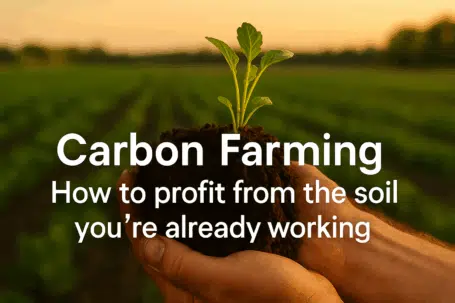The objective to limit global warming to 1.5°C is a matter of established policy. Current trajectories indicate this target is unlikely to be met, with projections suggesting a 3°C increase by the end of the century. This is the baseline reality.
Within this context, multiple public and private sector strategies are being deployed to reduce greenhouse gas (GHG) emissions. While many organizations have committed to carbon neutrality, certain sectors, notably air transport and heavy industry, face significant technical barriers to full decarbonization.
Consequently, carbon offsets function as a required mechanism to neutralize residual emissions. The process involves the removal or sequestration of an equivalent quantity of GHGs in carbon sinks. This is not a panacea; it is a tool. To achieve the mandated 45% reduction in GHG emissions by 2030 and net-zero by 2050, a considerable expansion of functional, credible carbon offset programs and markets is a logistical necessity.
Market Function and Investment Logic
Carbon markets contribute the “Net” to the “Net Zero” equation. Their primary function is to accelerate climate action by capitalizing on the marginal cost of abatement. This allows for the optimization of capital by targeting interventions where emissions can be reduced most efficiently and cost-effectively. These markets are a complement to, not a substitute for, government regulation and internal corporate efforts to reduce emissions within their own operational value chains.
A consensus exists on two primary pathways for emissions reduction:
- Technological Solutions: Primarily wind and solar, with a potential to reduce annual emissions by over 20% (approx. 8 billion tonnes CO2e) by 2030.
- Ecological (Nature-Based) Solutions: Including avoided deforestation, agricultural carbon sequestration, and ecosystem restoration, with a potential to generate up to 30% of required annual emissions reductions by 2030.
A significant financing gap, particularly in developing countries, impedes the large-scale deployment of these solutions. The carbon credit market is the designated financial mechanism to address this gap.
For these markets to function effectively, they must be reliable and transparent. Incentives must be aligned. Buyers and sellers require confidence in the technical quality of the product—the carbon credit and the integrity of the transaction itself.
The Foundational Principles of a Credible Credit
A carbon offset is an instrument defined as the reduction, avoidance, or sequestration of one tonne of CO2 equivalent. For this instrument to have environmental integrity, it must adhere to a set of rigorous, non-negotiable methodological rules. Projects that generate credits must demonstrate that the GHG reductions or removals are real, measurable, verifiable, permanent, and additional. If these criteria are not met, the instrument fails.
Table 1: The Quality Assurance Criteria for GHG Offsetting
- Real: All claimed GHG emissions reductions must be demonstrated as having actually occurred.
- Measurable: All avoided or reduced GHG emissions must be quantifiable against a validated, recognized methodology (e.g., ISO 14064-2, GHG Protocol).
- Verifiable: A reduction must be fully documented to a degree sufficient for an independent third-party verifier to confirm its accuracy and realization through an objective review
- Permanent: The offset must be durable and irreversible. Given that atmospheric CO2 has a permanence of approximately 100 years, sequestration-based projects must demonstrate, at minimum, a 100-year permanence standard.
- Additional: This principle ensures the reduction is a direct result of the project and exceeds the “business-as-usual” baseline scenario. The project must be additional to all current regulations and common practices. Financial additionality dictates that the project would not have been viable without the carbon offset program incentive. All projects must quantify a baseline; only the delta between the baseline and project scenarios is eligible for crediting.
- Absence of Leakage: The project must not cause an increase in GHG emissions outside its established perimeter that would partially or wholly negate the project’s climate benefit.
- Unique: Each carbon credit must correspond to a single, unique tonne of GHG reduction. Double counting must be prevented through mechanisms such as the individual serialization of each verified tonne and the use of a transparent registry.
An Overview of Carbon Market Structures
Carbon markets are classified into two primary types, differentiated by the motivation of the purchaser.
1. Regulated (Compliance) Markets
- Mechanism: Typically an Emissions Trading Scheme (ETS) based on the “polluter-pays” principle.
- Participants: Emitting companies covered by regulation. Options include internal reduction, purchasing allowances from other companies, or purchasing offset credits from projects in non-regulated sectors.
- Structure: Homogenous, with a single set of rules and targets established by law. Transactions are often structured via auctions.
- Scope: As of 2023, 73 carbon pricing systems (both ETS and taxes) are in place across 36 jurisdictions, covering approximately 25% of global GHG emissions.
2. Voluntary Carbon Markets
These are mechanisms for the voluntary exchange of offset credits, operating outside of regulatory mandates.
- Mechanism: Based on the voluntary actions of organizations and individuals. There are no government-imposed emissions caps or reduction targets.
- Participants: A wide range of buyers with varied motivations (see Table 2).
- Structure: Heterogeneous, with a diverse array of standards, methodologies, and procedures. Transactions are typically conducted “over-the-counter.”
Table 2: Buyer Categories and Motivations in the Voluntary Carbon Market
- States or non-regulated emitters: Achieving voluntary climate targets; enhancing public image; reducing environmental impact.
- Pre-regulated emitters: Anticipating future compliance obligations.
- Banks and Investment Funds: Fulfilling voluntary commitments; speculating on future credit prices.
- Events, small emitters, individuals: Fulfilling voluntary commitments; environmental conviction.
Classification of Offset Projects
Voluntary offset credits are generated via two distinct outcomes:
- Projects that reduce or avoid GHG emissions into the atmosphere.
- Projects that remove GHG emissions from the atmosphere (carbon removal credits).
These projects are further categorized by their underlying methodology as either nature-based or technological solutions.



